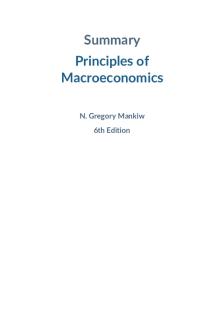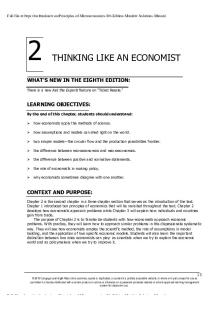CH 16 Notes Principles of Macroeconomics, 8th Edition by Gregory Mankiw PDF

| Title | CH 16 Notes Principles of Macroeconomics, 8th Edition by Gregory Mankiw |
|---|---|
| Course | Macroeconomics |
| Institution | Century College |
| Pages | 10 |
| File Size | 254.1 KB |
| File Type | |
| Total Downloads | 48 |
| Total Views | 155 |
Summary
Ch. 16: The Monetary System
- PowerPoint/textbook notes
- Book: Principles of Macroeconomics, 8th Edition by Gregory Mankiw
- Used with Cengage Online Learning...
Description
CHAPTER 16 The Meaning of Money Money Set of assets in an economy That people regularly use To buy goods and services from other people The functions of money Medium of exchange Unit of account Store of value Medium of exchange Item that buyers give to sellers When they want to purchase goods and services Unit of account Yardstick people use to post prices and record debts Store of value Item that people can use to transfer purchasing power From the present to the future Liquidity Ease with which an asset can be converted into the economy’s medium of exchange The Kinds of Money
Commodity money Money that takes the form of a commodity with intrinsic value Intrinsic value Item would have value even if it were not used as money Gold standard - Gold as money Or paper money that is convertible into gold on demand Fiat money Money without intrinsic value Used as money because of government decree Fiat Order or decree Money in the U.S. Economy
Money stock Quantity of money circulating in the economy Currency Paper bills and coins in the hands of the public Demand deposits Balances in bank accounts - depositors can access on demand by writing a check Measures of money stock M1
Demand deposits, Traveler’s checks Other checkable deposits, Currency M2 Everything in M1 Savings deposits, Small time deposits Money market mutual funds A few minor categories Figure 1: Two Measures of the Money Stock for the U.S. Economy
• The two most widely followed measures of the money stock are M1 and M2. This figure shows the size of each measure in 2009. Where is all the currency? 2009: $862 billion currency outstanding Average adult: holds about $3,653 of currency Much of the currency is held abroad Much of the currency is held by drug dealers, tax evaders, and other criminals
Currency – not a particularly good way to hold wealth Can be lost or stolen Doesn’t earn interest The Federal Reserve System Federal Reserve (Fed) The central bank of the United States
Central bank Institution designed to Oversee the banking system Regulate the quantity of money in the economy The Fed’s Organization The Federal Reserve Created in 1913 After a series of bank failures in 1907 Purpose: to ensure the health of the nation’s banking system Board of governors 7 members, 14-year terms Appointed by the president & confirmed by the Senate The chairman Directs the Fed staf Presides over board meetings Testifies regularly about Fed policy in front of congressional committees. Appointed by the president (4-year term) The Federal Reserve System Federal Reserve Board in Washington, D.C.
12 regional Federal Reserve Banks Major cities around the country The presidents - chosen by each bank’s board of directors The Fed’s jobs Regulate banks & ensure the health of the banking system Regional Federal Reserve Banks Monitors each bank’s financial condition Facilitates bank transactions - clearing checks Acts as a bank’s bank The Fed – lender of last resort The Fed’s jobs Control the money supply Quantity of money available in the economy Monetary policy By Federal Open Market Committee (FOMC) Money supply Quantity of money available in economy Monetary policy Setting of the money supply Federal Open Market Committee FOMC 7 members of the board of governors 5 of the twelve regional bank presidents All twelve regional presidents attend each FOMC meeting, but only five get to vote
Meets about every six weeks in Washington, D.C. Discuss the condition of the economy Consider changes in monetary policy Fed’s primary tool: open-market operation Purchase & sale of U.S. government bonds FOMC - increase the money supply The Fed: open-market purchase FOMC - decrease the money supply The Fed: open-market sale Banks and the Money Supply Reserves Deposits that banks have received but have not loaned out The simple case of 100% reserve banking All deposits are held as reserves
Banks do not influence the supply of money Fractional-Reserve Banking
Fractional-reserve banking Banks hold only a fraction of deposits as reserves Reserve ratio Fraction of deposits that banks hold as reserves Reserve requirement Minimum amount of reserves that banks must hold; set by the Fed Excess reserve Banks may hold reserves above the legal minimum Example: First National Bank Reserve ratio 10%
Banks hold only a fraction of deposits in reserve Banks create money Assets Liabilities Increase in money supply Does not create wealth The Money Multiplier
The money multiplier Original deposit = $100.00 First National lending = $ 90.00 [= .9 × $100.00] Second National lending = $ 81.00 [= .9 × $90.00] Third National lending = $ 72.90 [= .9 × $81.00] … Total money supply = $1,000.00 The money multiplier Amount of money the banking system generates with each dollar of reserves Reciprocal of the reserve ratio = 1/R The higher the reserve ratio The smaller the money multiplier
Fed’s Tools of Monetary Control Influences the quantity of reserves Open-market operations Fed lending to banks Influences the reserve ratio Reserve requirements Paying interest on reserves Open-market operations Purchase and sale of U.S. government bonds by the Fed To increase the money supply The Fed buys U.S. government bonds To reduce the money supply The Fed sells U.S. government bonds Used more often Fed lending to banks To increase the money supply Discount window At the discount rate Term Auction Facility To the highest bidder The discount rate Interest rate on the loans that the Fed makes to banks Higher discount rate Reduce the money supply Smaller discount rate Increase the money supply Reserve requirements
Regulations on minimum amount of reserves That banks must hold against deposits An increase in reserve requirement Decrease the money supply A decrease in reserve requirement Increase the money supply Used rarely – disrupt business of banking Paying interest on reserves Since October 2008 The higher the interest rate on reserves The more reserves banks will choose to hold An increase in the interest rate on reserves Increase the reserve ratio Lower the money multiplier Lower the money supply The Federal Funds Rate The federal funds rate Interest rate at which banks make overnight loans to one another Lender – has excess reserves Borrower – needs reserves A change in federal funds rate Changes other interest rates Fed: target the federal funds rate Open-market operations The Fed buys Decrease in the federal funds rate Increase in money supply The Fed sells Increase in the federal funds rate Decrease in money supply...
Similar Free PDFs

Mankiw - macroeconomics 5th edition
- 462 Pages
Popular Institutions
- Tinajero National High School - Annex
- Politeknik Caltex Riau
- Yokohama City University
- SGT University
- University of Al-Qadisiyah
- Divine Word College of Vigan
- Techniek College Rotterdam
- Universidade de Santiago
- Universiti Teknologi MARA Cawangan Johor Kampus Pasir Gudang
- Poltekkes Kemenkes Yogyakarta
- Baguio City National High School
- Colegio san marcos
- preparatoria uno
- Centro de Bachillerato Tecnológico Industrial y de Servicios No. 107
- Dalian Maritime University
- Quang Trung Secondary School
- Colegio Tecnológico en Informática
- Corporación Regional de Educación Superior
- Grupo CEDVA
- Dar Al Uloom University
- Centro de Estudios Preuniversitarios de la Universidad Nacional de Ingeniería
- 上智大学
- Aakash International School, Nuna Majara
- San Felipe Neri Catholic School
- Kang Chiao International School - New Taipei City
- Misamis Occidental National High School
- Institución Educativa Escuela Normal Juan Ladrilleros
- Kolehiyo ng Pantukan
- Batanes State College
- Instituto Continental
- Sekolah Menengah Kejuruan Kesehatan Kaltara (Tarakan)
- Colegio de La Inmaculada Concepcion - Cebu














